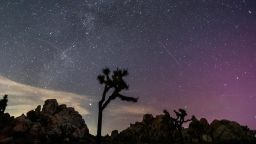Science
Orionid Meteor Shower Peaks This Week: What You Need to Know

Sky-gazers around the globe can expect a spectacular display as the Orionid meteor shower peaks on October 23, 2023. This celestial event is anticipated to deliver bright shooting stars across the night sky, making it an ideal opportunity for astronomy enthusiasts and casual observers alike. The shower is particularly notable this year as it coincides with a new moon, which means the darkness of the night will enhance visibility without interference from moonlight.
According to EarthSky, the peak viewing time is expected at 8 p.m. ET on Monday. However, the Orionid meteor shower does not feature a sharp peak. Robert Lunsford, fireball report coordinator for the American Meteor Society, noted that those who face cloudy conditions on the night of the peak should not lose hope. “Head on out the next night, next couple nights even, and you’ll see almost the same activity,” he advised.
Under optimal weather conditions, viewers can expect to see between 10 to 20 meteors per hour. The meteors are notably fast, with most visible for only a fraction of a second. Lunsford explained that “the brighter ones do produce persistent trains, which are smoke trails after the meteor has disappeared.”
Where Do the Orionids Come From?
The Orionid meteor shower occurs when Earth traverses debris left by the comet 1P/Halley. This comet crosses Earth’s orbit twice, entering in October and exiting in early May. During its October passage, the debris creates the Orionids, while the subsequent May passage results in the Eta Aquariid meteor shower. Lunsford mentioned that Halley’s comet was last visible from Earth in 1986, and its orbital period is approximately 76 years. This means that it is expected to reappear in the night sky in 2061.
For the best viewing experience, observers are advised to look towards the southern sky around 10 p.m. on Monday night or between 4 to 5 a.m. on Tuesday morning, local time. This timing allows for optimal visibility when the meteors are most active.
Upcoming Meteor Showers
In addition to the Orionids, sky-watchers can look forward to another meteor shower, the Southern Taurids, which is expected to peak on November 4-5, 2023. This event will coincide with a full moon, presenting a different viewing challenge compared to the Orionids. The Taurids, which are much slower than the Orionids, originate from the constellation Taurus, creating a dynamic interplay of meteor activity in the night sky.
As enthusiasts prepare for this week’s celestial event, the Orionid meteor shower presents an exciting opportunity to connect with the cosmos. Whether you are a seasoned astronomer or a casual observer, the night sky promises a brilliant show.
-

 Science2 months ago
Science2 months agoInventor Achieves Breakthrough with 2 Billion FPS Laser Video
-

 Health2 months ago
Health2 months agoCommunity Unites for 7th Annual Into the Light Walk for Mental Health
-

 Top Stories2 months ago
Top Stories2 months agoCharlie Sheen’s New Romance: ‘Glowing’ with Younger Partner
-

 Entertainment2 months ago
Entertainment2 months agoDua Lipa Aces GCSE Spanish, Sparks Super Bowl Buzz with Fans
-

 Health2 months ago
Health2 months agoCurium Group, PeptiDream, and PDRadiopharma Launch Key Cancer Trial
-

 Top Stories2 months ago
Top Stories2 months agoFormer Mozilla CMO Launches AI-Driven Cannabis Cocktail Brand Fast
-

 Entertainment2 months ago
Entertainment2 months agoMother Fights to Reunite with Children After Kidnapping in New Drama
-

 World2 months ago
World2 months agoR&B Icon D’Angelo Dies at 51, Leaving Lasting Legacy
-

 World2 months ago
World2 months agoIsrael Reopens Rafah Crossing After Hostage Remains Returned
-

 Business2 months ago
Business2 months agoTyler Technologies Set to Reveal Q3 Earnings on October 22
-

 Health2 months ago
Health2 months agoNorth Carolina’s Biotech Boom: Billions in New Investments
-

 Health2 months ago
Health2 months agoYouTube Launches New Mental Health Tools for Teen Users









